Need help or advice? 52164-021
2-Component Waterproofing
This unique Sahand Chemical product is used to waterproof all vertical and horizontal surfaces in contact with water.
Sahand Chemical two-component waterproofing is obtained by combining a cement-based powder part with a polymer resin part and due to creating complete waterproofing with low thickness and reducing the weight of the structure, long life, high flexibility, excellent adhesion and ease of execution, without the need for heat, has become a reliable option to replace isogum and bitumen in various waterproofing projects.
Each pack of this product includes a 20 kg bag of powder and a 10 liter gallon of resin.
30,000,000 ریال
Sahand Chemical Two-Component Waterproofing
Sahand Chemical two-component waterproofing is used to waterproof floors and walls of various bathrooms and showers, water tanks, concrete roofs and slabs, roofs and roof gardens, swimming pools, fountains, sewage treatment plants and other tanks under positive hydrostatic water pressure.
To buy and view various Sahand Chemical concrete waterproofing agents, please visit link to the concrete waterproofing page.
Two-Component Waterproofing
The most important feature of this cement-based product is its suitable flexibility, high adhesion and ability to create complete waterproofing with a very low thickness. Sahand Chemical two-component waterproofing has a technical certificate from the Research Center of the Ministry of Roads, Housing and Urban Development.
This product has the ability to be applied on all vertical and horizontal surfaces of concrete, cement, stone and metal floors and walls and each pack of it allows waterproofing 10 to 15 square meters of surface. One of the notable points of two-component cement-based waterproofing is the possibility of direct tiling on it using suitable tile adhesive.
Comparison of Two-Component Waterproofing with Isogum and Bitumen
For many years, the use of isogum and bitumen has been a common method for waterproofing various surfaces. Two-component waterproofing is referred to as a modern alternative to isogum. These two have fundamental differences in nature and execution, some of which are mentioned below:
Possibility of Direct Tiling
It is not possible to tile directly on isogum. Usually, for this purpose, rebar mesh is done on isogum and mortar is poured. This method, in addition to being time-consuming, makes the structure heavier and is generally accompanied by damage to the isogum.
In another method, isogum is first done and then walling and tiling are done on it, which may make the interior space a little smaller. In contrast, tiling on two-component waterproofing is done directly using suitable tile adhesive and there is no need for additional walling.
Comparison in Terms of Adhesion
Isogum is designed to adhere to horizontal surfaces and does not have sufficient and reliable adhesion on vertical surfaces. On vertical surfaces, isogum may peel off over time or not be able to resist well, unless it is stabilized with special adhesives. For this reason, it is better to use two-component waterproofing for insulating vertical surfaces, which have more adhesion on these surfaces and create better durability.
Two-component waterproofing, due to its polymer part, creates a strong connection with the underlying surface that is not affected by stresses and temperature fluctuations and in this regard has a significant advantage over isogum.
Comparison in Terms of Lifespan
The lifespan of isogum is relatively short. While two-component waterproofing is a cement-based product and due to its cement part, if used as an intermediate layer, it will have a lifespan equal to the lifespan of the structure.
Comparison in Terms of Environmental Compatibility
The pollution and dirt caused by soot and bitumen in the preparation and execution stages of isogum and bitumen, especially in indoor spaces and renovation projects, is very high. In contrast, the preparation and execution of two-component waterproofing is much cleaner and without additional pollution, without the need for heat and without creating an unpleasant odor compared to isogum and bitumen.
Applications of Two-Component Waterproofing
It is possible to use two-component waterproofing in all places where isogum can be applied:
- Floors and walls of all kinds of recreational, agricultural and industrial pools.
- Floors and walls of bathrooms and toilets.
- All kinds of roofs, terraces and roof gardens.
- All kinds of facade walls and western rain-catching side walls.
- All kinds of ponds and fountains.
Sahand Chemical two-component waterproofing has a high preparation and execution speed and saves a lot of money and time.
Resistance of Two-Component Waterproofing to Building Stresses
The acrylic resin-based polymer part in two-component waterproofing, in addition to the high adhesion strength that it provides for bonding to concrete or cement surfaces, makes this two-component cement-based compound flexible.
Due to this feature, the waterproofing layer created with the ability to bridge cracks shows excellent resistance against breakage caused by structural stresses and building settlements.
Operating Temperature of Two-Component Waterproofing
This product can be used in the temperature range of -20 to +70 degrees Celsius. The results of the tests of the Research Center of the Ministry of Roads, Housing and Urban Development in this temperature range are available in the downloads section.
Two-Component Waterproofing as the Final Layer
It is possible to use Sahand Chemical two-component waterproofing for cases such as ponds, fountains or agricultural pools that are less likely to be hit and damaged as the final layer.
But due to the physical conditions and low thickness of this product, it is relatively vulnerable and is not recommended as the final layer. Therefore, applying a protective layer such as a combination of cement and concrete adhesive or tiles on it will increase the lifespan of the waterproofing several times.
Use in Environments with Negative Pressure
Sahand Chemical two-component waterproofing is designed for use in positive hydrostatic pressures and is not effective for places with negative pressure.
Suitable Surface Materials for Waterproofing
The best surface for waterproofing with Sahand Chemical two-component waterproofing is a concrete or cement surface. These surfaces are most compatible with cement-based waterproofing. The possibility of applying this product on different surfaces is shown in the table below:
| Surface material | Possibility of using a two-part seal | Description |
| Concrete/Cement | ✔ | Fully compatible |
| Insulation | ✘ | It can be used to temporarily repair the surface of the insulation. |
| Plaster | ✔ | Primer must be used for the following work. |
| Thatch/Clay | ✔ | Primer must be used for the following work. |
| Asphalt | ✘ | |
| Tile / Ceramic / Mosaic | ✔ | For better results, the surface should be rough (axillary). |
| Metal | ✔ | Before use, the metal surface must be clean and free of any rust, and a primer must be used for the undercoat. |
Waterproofing Gypsum Walls with Two-Component Waterproofing
Gypsum surfaces, due to their very low strength and high moisture absorption, are unsuitable and weak substrates for applying two-component waterproofing. These surfaces have high moisture absorption, which leads to blistering and simultaneous release of gypsum and waterproofing from the surface.
If you are forced to waterproof a gypsum wall, the use of Sahand Chemical construction primer on the surface before waterproofing is mandatory.
Waterproofing Tiled Pools
In terms of adhesion, two-component waterproofing can be easily applied to tiles and ceramics. However, since this product is a cement-based and non-transparent mortar, the old tiles cannot be seen after waterproofing, and there is a need to re-tile on the waterproofing layer with a suitable tile adhesive.
In such cases, the more principled method is to demolish the tiles and prepare the concrete surface before waterproofing. If it is not possible to demolish the old tiles and to achieve better results, it is recommended to roughen or chisel the surface using a grinder.
Using Two-Component Waterproofing in Building Facades
Since Sahand Chemical two-component waterproofing creates a non-transparent and cementitious coating, using it as the final layer on the facade will cover the appearance of the facade. Therefore, it is recommended to do the waterproofing with two-component waterproofing before the facade is executed, and then do the facade of the building with a suitable method on it so that the final facade is preserved in the desired shape.
To prevent water penetration from the facade of the building, it is necessary to cover the back wall surface with two-component waterproofing before installing the facade stones, and then proceed to install the facade stones.
Otherwise, by applying Sahand Chemical facade water repellent product on surfaces with water absorption, moisture absorption into the building can be prevented to some extent.
Calculating the Required Amount of Two-Component Waterproofing
The consumption volume of two-component waterproofing depends heavily on how it is applied. Usually, each pack of Sahand Chemical two-component waterproofing, which includes a 20 kg bag of cement-based powder and a 10 liter gallon of polymer resin, covers an area of 10 to 15 square meters.
To calculate the amount of two-component waterproofing you need, you can use the calculator on this page or the calculator page.
How to Prepare Two-Component Waterproofing
Mix each 20 kg bag of Sahand Chemical two-component waterproofing powder with 10 liters of resin using an electric mixer. (2 to 1 weight ratio)
To do this, first pour the resin into a container with a suitable capacity and slowly add the powder to the resin while stirring and continue mixing until a uniform and homogeneous mortar is obtained.
Let the mortar rest for 5 minutes and then mix it again a little. Now the waterproofing is ready to use. It is important to note that no water or other material should be added to the waterproofing compound.
Substrate Surface Conditions
Surface preparation for waterproofing is one of the most important and decisive steps in the final quality of the work. For this purpose, first, using a grinder, the cracks should be opened to the required depth and the loose points should be demolished. Then the surface is cleaned of any contamination, dust, paint and grease.
Using Primer and Repair Mortar
After cleaning the surface, it is time to apply Sahand Chemical construction primer to increase adhesion and reduce water absorption of the surface, and then fill the surface defects with suitable repair mortar. Using primer significantly increases the adhesion of the surface and prevents the absorption of water in the two-component waterproofing by the surface.
This has a significant effect on increasing the quality and lifespan of the waterproofing. The primer is applied as a thin layer with a brush or roller on the surface and after a little drying, it is ready for the application of repair mortar.
How to Apply Two-Component Waterproofing
Use a clean container to mix the product. First, pour the liquid part into the container and while the mixer is stirring the liquid part, slowly add the powder part and continue mixing until a homogeneous and uniform mortar is obtained.
This product can be easily applied by brush, roller, trowel and spatula. For waterproofing application, first apply the first layer in one direction (horizontal or vertical) on the surface and the waterproofing mesh is placed on it. The thickness of the first layer should be such that the mesh is well covered by the waterproofing.
After 2 to 24 hours (depending on the air temperature) the second layer is applied perpendicular to the first layer. Note that the total thickness of both layers along with the waterproofing mesh should not exceed 3 mm, because there is a possibility of cracking of the waterproofing in greater thicknesses.
Using Waterproofing Mesh
Corners, pipe outlets and inlets, connection points of structures in prefabricated walls and points with the possibility of cracking should be reinforced by waterproofing mesh. In these points, due to increased stress, the possibility of cracking is high.
Operating Temperature and Workability Time
The best operating temperature for Sahand Chemical two-component waterproofing is between 5 and 40 degrees Celsius. At lower temperatures, the drying time of the waterproofing will be longer.
The shelf life of two-component waterproofing after mixing with resin (workability time) depends on various factors such as ambient temperature and the volume of prepared waterproofing mortar. In general, to create the best performance of two-component waterproofing, it is recommended to prepare only the amounts needed for waterproofing up to a maximum of 1 hour and then proceed to make new waterproofing.
Coloring
Sahand Chemical two-component waterproofing is dark gray and can also be ordered in light gray color. Acrylic water-based paints can also be used to apply color to two-component waterproofing.
Setting Time
The initial setting time of Sahand Chemical two-component waterproofing is between 2 and 24 hours (depending on the air temperature) and is ready for water test after 7 days. This time depends on various factors such as temperature, humidity, waterproofing thickness and execution conditions and may be shorter or longer.
Expiration Date and Storage Conditions
Sahand Chemical two-component waterproofing can be used for up to one year if stored in its packaging and in a dry place away from direct sunlight and moisture.
Note: In environments with acidic pH, it is recommended that the two-component waterproofing not be in direct contact with acid. For this purpose, a suitable coating that has good adhesion to the two-component waterproofing can be used, or tiles can be installed to prevent direct contact of the two-component waterproofing with acid.
Since two-component waterproofing is a cement and resin based product, it can change the drinking water factors, so if used in drinking water tanks, it is recommended to use a suitable coating that has the necessary adhesion to two-component waterproofing, or if a suitable coating is not used, be sure to purify the water to adjust the amount of ions in drinking water according to the standard.






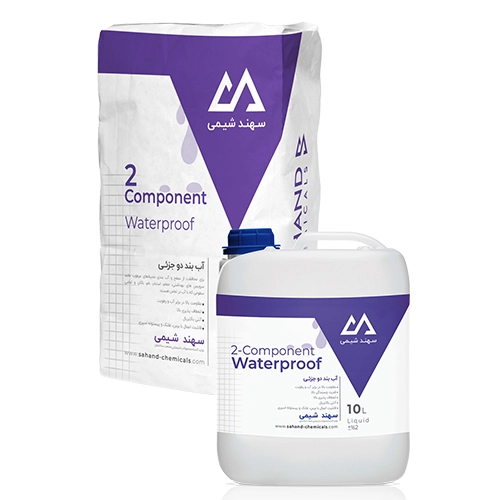
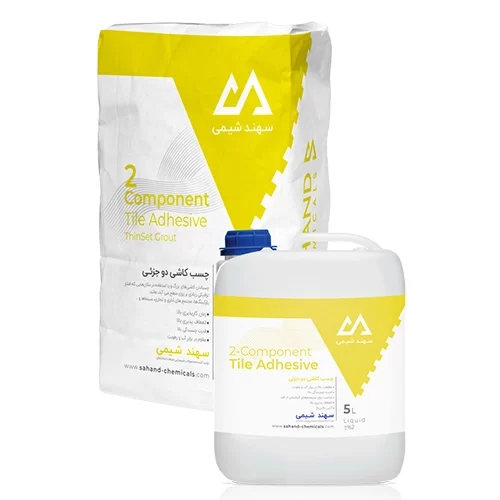
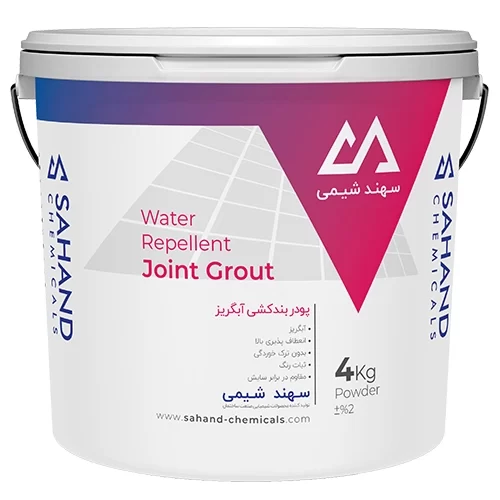
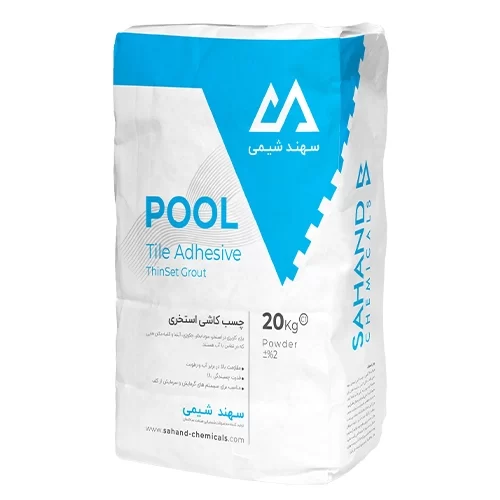

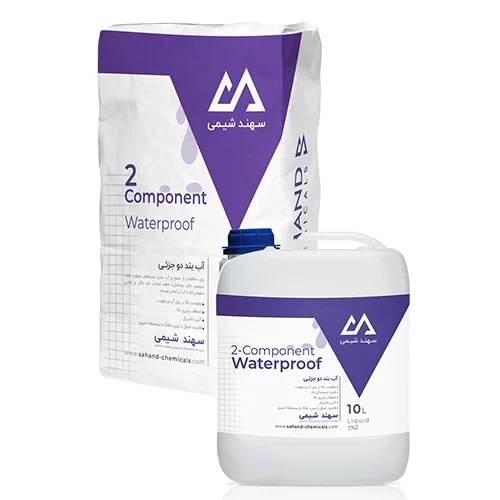
1 review for 2-Component Waterproofing
There are no reviews yet.